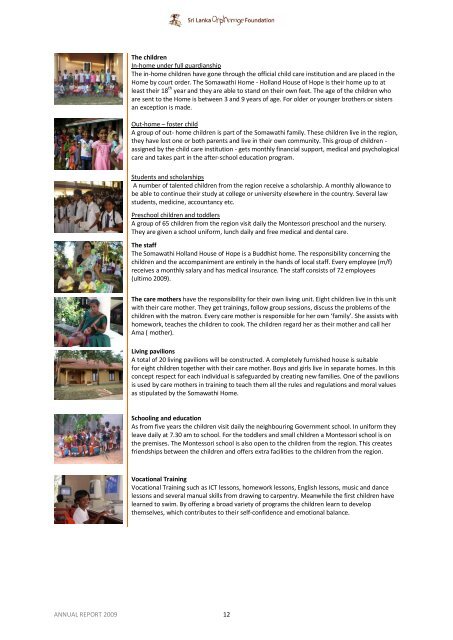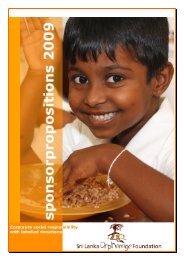annual report 2009 - Stichting Weeshuis Sri Lanka
annual report 2009 - Stichting Weeshuis Sri Lanka
annual report 2009 - Stichting Weeshuis Sri Lanka
Create successful ePaper yourself
Turn your PDF publications into a flip-book with our unique Google optimized e-Paper software.
The children<br />
In-home under full guardianship<br />
The in-home children have gone through the official child care institution and are placed in the<br />
Home by court order. The Somawathi Home - Holland House of Hope is their home up to at<br />
least their 18 th year and they are able to stand on their own feet. The age of the children who<br />
are sent to the Home is between 3 and 9 years of age. For older or younger brothers or sisters<br />
an exception is made.<br />
Out-home – foster child<br />
A group of out- home children is part of the Somawathi family. These children live in the region,<br />
they have lost one or both parents and live in their own community. This group of children -<br />
assigned by the child care institution - gets monthly financial support, medical and psychological<br />
care and takes part in the after-school education program.<br />
Students and scholarships<br />
A number of talented children from the region receive a scholarship. A monthly allowance to<br />
be able to continue their study at college or university elsewhere in the country. Several law<br />
students, medicine, accountancy etc.<br />
Preschool children and toddlers<br />
A group of 65 children from the region visit daily the Montessori preschool and the nursery.<br />
They are given a school uniform, lunch daily and free medical and dental care.<br />
The staff<br />
The Somawathi Holland House of Hope is a Buddhist home. The responsibility concerning the<br />
children and the accompaniment are entirely in the hands of local staff. Every employee (m/f)<br />
receives a monthly salary and has medical insurance. The staff consists of 72 employees<br />
(ultimo <strong>2009</strong>).<br />
The care mothers have the responsibility for their own living unit. Eight children live in this unit<br />
with their care mother. They get trainings, follow group sessions, discuss the problems of the<br />
children with the matron. Every care mother is responsible for her own ‘family’. She assists with<br />
homework, teaches the children to cook. The children regard her as their mother and call her<br />
Ama ( mother).<br />
Living pavilions<br />
A total of 20 living pavilions will be constructed. A completely furnished house is suitable<br />
for eight children together with their care mother. Boys and girls live in separate homes. In this<br />
concept respect for each individual is safeguarded by creating new families. One of the pavilions<br />
is used by care mothers in training to teach them all the rules and regulations and moral values<br />
as stipulated by the Somawathi Home.<br />
Schooling and education<br />
As from five years the children visit daily the neighbouring Government school. In uniform they<br />
leave daily at 7.30 am to school. For the toddlers and small children a Montessori school is on<br />
the premises. The Montessori school is also open to the children from the region. This creates<br />
friendships between the children and offers extra facilities to the children from the region.<br />
Vocational Training<br />
Vocational Training such as ICT lessons, homework lessons, English lessons, music and dance<br />
lessons and several manual skills from drawing to carpentry. Meanwhile the first children have<br />
learned to swim. By offering a broad variety of programs the children learn to develop<br />
themselves, which contributes to their self-confidence and emotional balance.<br />
ANNUAL REPORT <strong>2009</strong> 12






